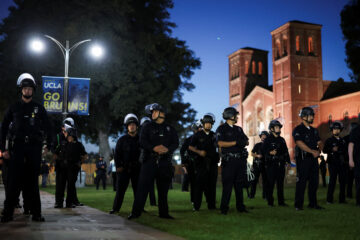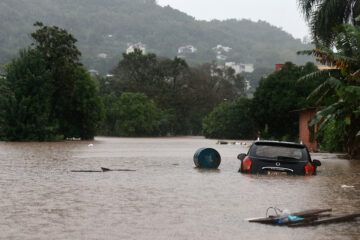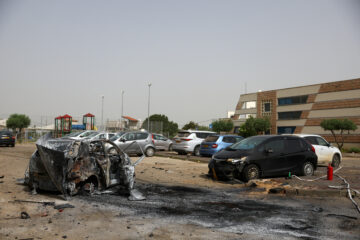Hundreds dead after massive earthquake hits South Asia
More than 300 people were killed Monday when a powerful 7.5-magnitude earthquake centred in the Hindu Kush mountains in Afghanistan ripped across South Asia, toppling buildings, triggering stampedes and knocking out communication lines.
The full scale of the disaster and human toll was unclear when night fell over the remote and rugged terrain as authorities in Pakistan and Afghanistan rushed to mount rescue efforts.
In the most horrifying tragedy to emerge so far from the quake, 12 young Afghan girls were crushed to death in a stampede as they tried to flee their shaking school building.
The bulk of the casualties were reported from Pakistan, where 230 people were killed and more than 1,629 injured, disaster management authorities said.
"Many houses and buildings have collapsed in the city," said Arbab Muhammad Asim, district mayor for the northwestern city of Peshawar.
Many people were trapped under piles of rubble, with officials warning that the toll was set to rise.
"The building was swinging like a pendulum, it felt as if the heavens would fall," Peshawar shop owner Tufail Ahmed told AFP.
Afghan officials said at least 76 people were confirmed dead and hundreds more injured, with casualties reported from around half a dozen of the country\’s 34 provinces.
The government has implored aid agencies for relief.
But large swathes of Badakhshan, the remote province where the epicentre is located, and other areas are effectively controlled by the Taliban, posing a huge challenge to any official aid efforts.
"Today\’s earthquake was the strongest one felt in the recent decades," said Afghanistan\’s chief executive Abdullah Abdullah.
"Initial reports show a big loss of life and huge financial losses in Badakhshan, Takhar, Nangarhar, Kunar and other regions. Exact numbers are not known because phone lines are down and communication has been cut off in many areas."
A dozen Afghan schoolgirls, all under 16, were trampled to death in the remote northern province of Takhar as they rushed to escape their classrooms when the quake struck.
Bystanders rushed the dazed and terrified survivors to hospital, many lying limp in the arms of their rescuers, as doctors tried reviving some of them by pumping their chests manually.
"When the aggrieved relatives of the dead students came to collect their bodies, they were so distressed that they could not even talk to authorities to record their names," said Hafizullah Safai, head of the Takhar health department.
The quake was centred near Jurm in northeast Afghanistan, 250 kilometres (160 miles) from the capital Kabul and at a depth of 213.5 kilometres, the US Geological Survey said.
The quake, which lasted at least one minute, shook buildings in Afghanistan, Pakistan and India, sending thousands of frightened people rushing into the streets.
Traffic came to a halt in downtown Kabul, with frightened people getting out of their cars as they waited for the quake to stop.
Live footage from an Afghan news broadcast filmed in Kabul showed the anchor abandoning his desk as the quake shook the cameras.
Restaurants and office buildings emptied in Islamabad, with cracks appearing in some buildings but no major damage reported.
Hundreds of people in northern India poured onto the streets from office blocks, hospitals and homes.
Delhi\’s metro ground to a halt during the tremor although the airport continued operating.
In the Kashmir region, panicked residents evacuated buildings and children were seen huddling together outside their school in the main city of Srinagar.
The rescue effort was being complicated by the lack of communications, with the region\’s already fragile infrastructure hit.
Gul Mohammad Bidar, deputy governor of Badakhshan in Afghanistan, told AFP lines were down and it was difficult to reach stricken communities.
"The earthquake was very powerful — buildings have been damaged (in Faizabad) and there are possible casualties," he said.
Indian Prime Minister Narendra Modi took to Twitter immediately after the quake, saying that India stood ready to assist, including in Afghanistan and Pakistan if required.
Pakistan mobilised troops and all military hospitals were put on high alert, army spokesman Lieutenant General Asim Bajwa said, with the air force also offering support.
Afghanistan is frequently hit by earthquakes, especially in the Hindu Kush mountain range, which lies near the junction of the Eurasian and Indian tectonic plates.
The epicentre of Monday\’s quake was just a few hundred kilometres from the site of a 7.6 magnitude quake that struck in October 2005, killing more than 75,000 people and displacing some 3.5 million more, although that quake was much shallower.
In Nepal twin quakes in May killed more than 8,900 people, triggered landslides and destroyed half a million homes.
SOURCE: AFP and agencies
[do_widget_area inner_adsbar]









